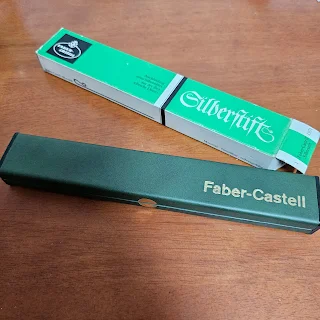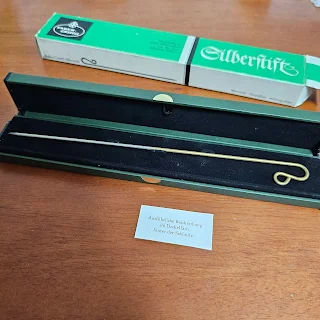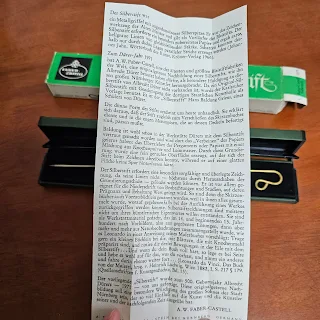FABER CASTELL SILBERSTIFT / FABER CASTELL SILVERPOINT
파버카스텔 은첨필 한정판 (1971)
Albrecht Dürer, a historic German artist, was born in Nuremberg in 1471.
Faber Castell, a historic German stationery company, was founded in Nuremberg in 1761.
Inevitably, Dürer has much meaning to Faber Castell.
Hence, when Faber Castell released its ambitious watercolor pencils and markers under the name of Albrecht Dürer.
It is no surprise that Faber Castell celebrated Dürer's 500th anniversary in a very special way.
It is contained in a long green case.
I always like this castell 9000 green color.
Since the world's first pencil "company" Faber Castell was established in 1761, there were no pencils when Dürer was alive.
Therefore, medieval artists including Dürer used silverpoints.
As the name suggests, people used tip of the sharp silver to draw things.
I dare to say silverpoints are the ancestor of pencils.
This one has two-tone colors of gold and silver.
I never used this so I don't know what I'll see when I draw with this.
Will it leave silver colored traces?
I'll give the translation below, but some points might be wrong.
The Silver Pencil was a semi-bright gray metal stylus that required old, dense lines from a layers master, especially more consistent and parallel than a pencil. The drawing tip yielded delicate, silver lines. It could be prepared as a precursor to John's Dictionary of Art - Kröner-Verlag strength. By the year 1971, A.W. Faber-Castell, one of the oldest and largest pencil factories in the world, had produced an accurate reproduction of the Silver Pencil, likely used by Albrecht Dürer, as a tribute to the great Nuremberg artist.
This Silver Pencil, as it appears today, was not in Dürer's possession. An original Silver Pencil from the Karlsruhe State Art Gallery was used as a model, with permission from the Kunsthalle. Hans Baldung, one of Dürer's pupils, may have become familiar with the Silver Pencil in Dürer's workshop and learned the technique of "verbing" the paper there, which involved overlaying a mixture of bone powder and parchment or paper with a glue-water solution. This provided a finely roughened surface on which the pencil could draw, leaving no trace on a smooth surface.
The Silver Pencil required particularly careful and thoughtful drawing since its lines could not be erased, except by scraping. It was ideally suited for precise and detailed work. Leonardo and other artists referred to source texts for more information on the use of the Silver Pencil.
Regarding its artistic value, your text mentions that this type of work was cataloged in a small booklet on artistic materials and their preservation, possibly written by Heinrich Ludwig. These observations and notes on the artistic value of the Silver Pencil are essential for the field of art history.
The text also discusses various aspects of the Silver Pencil's execution, its use of bone meal, and its appearance in the Malerbuches (Painter's Book) in Vienna in 1882. It suggests that these sketches and Silver Pencil drawings were compiled because they represent the beginning of a new era in art studies.
The Silver Pencil's unique properties are highlighted, and it is noted that it was not meant for regular use but for special, detailed work. The influence of the Silver Pencil on art is acknowledged, and A.W. Faber-Castell is credited with producing an accurate reproduction of it in 1971.










0 Comments